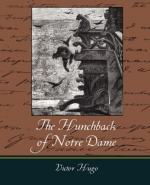|
This section contains 368 words (approx. 1 page at 400 words per page) |

|
The Hunchback of Notre Dame Summary & Study Guide Description
The Hunchback of Notre Dame Summary & Study Guide includes comprehensive information and analysis to help you understand the book. This study guide contains the following sections:
This detailed literature summary also contains Bibliography on The Hunchback of Notre Dame by Victor Hugo.
By the time Victor Hugo wrote The Hunchback of Notre Dame (published in French as Notre-Dame de Paris), he had already made a name for himself as a poet and dramatist. Although he had written one other novel (Han d'Islande, 1823), he had not really been known as a novelist. The Hunchback of Notre Dame was to change all that. Even more popular than it became throughout the twentieth century and into the early 2000s, this romantic story grabbed the imagination of the French people who embraced it for its melodramatic storyline and Hugo's detailed rendering of the life and culture of fifteenth-century Paris.
On the surface, The Hunchback of Notre Dame is a story of unrequited love between a man horribly disfigured and a beautiful woman who loves someone else. But Hugo was a very complex writer who gave his readers a much more complicated story. Underneath the unfolding of Quasimodo's love of La Esmeralda is a historical drama set in 1482, a time that in many ways mirrored the times and political struggles of Hugo's nineteenth-century world. With almost the entire novel set in the cathedral of Notre Dame, the novel also conveys a spiritual element not only in its setting but in its characters. There is a priest who has lost his spiritual path; there is a physically disfigured man who is shunned and must find solace not in the material world but deep within himself; and there is the beautiful woman, innocence personified, who searches for a spiritual form of love.
Although his contemporaries applauded his novel, in many ways Hugo's The Hunchback of Notre Dame was also shocking in its time. Hugo was, after all, a central figure of the Romantic Movement in literature. Readers, prior to Hugo's works, were used to literature that was influenced more by the classical form, which emphasized rational rather than emotional topics and points of view. Also, Hugo's main character, Quasimodo, is physically repulsive, whereas in classical works, writers focused on idealized form. The Hunchback of Notre Dame also focuses on the personal rather than on classical universal themes, which may be one of the reasons why the novel retained its popularity for almost two hundred years.
Read more from the Study Guide
|
This section contains 368 words (approx. 1 page at 400 words per page) |

|



